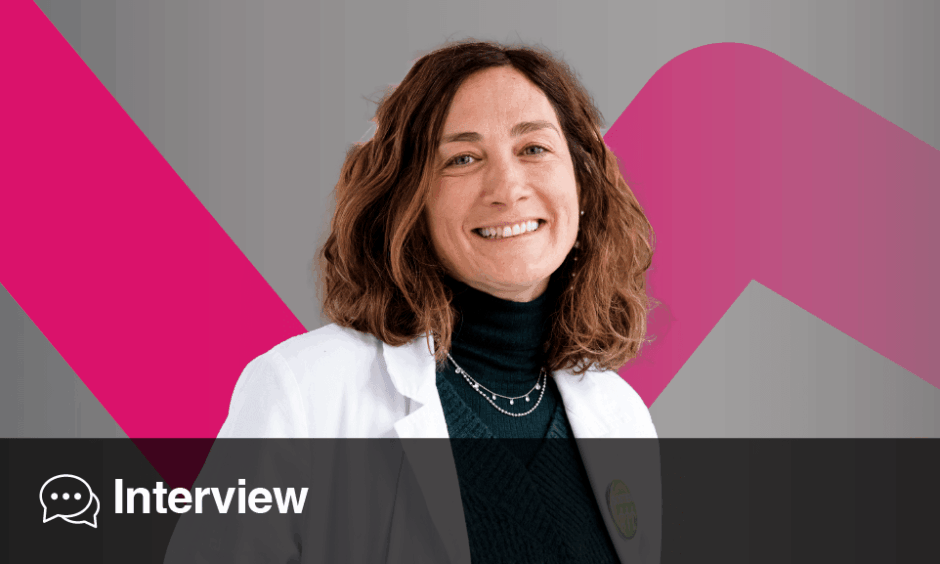Cynthia Dunbar | Secretary, American Society of Hematology (ASH); Chief, Translational Stem Cell Biology Branch, and Head, Molecular Hematopoiesis Section, National Heart, Lung and Blood Institute, National Institutes of Health, Bethesda, USA; Member, National Academy of Medicine (NAM), USA; Fellow, American Association for the Advancement of Science (AAAS), USA
Citation: EMJ Hematol. 2023; DOI/10.33590/emjhematol/10302040. https://doi.org/10.33590/emjhematol/10302040.
![]()
What inspired you to first pursue a career in medicine, to later specialise in haematology, and then more specifically find topics like stem cell biology and haematopoiesis?
I first got interested in a career in medicine because I found science courses really interesting at school, and I was good at them. In high school, I had a close friend with Hodgkin’s lymphoma, and that was my first exposure to blood diseases and blood cancer. Nobody in my family worked in the medical field, but they were perfectly happy for me to go into medicine. Surprisingly, I had more friends develop Hodgkin’s lymphoma and saw the different outcomes between my friend who died of it in the late 70s, when effective treatments were just starting to be developed, and then the early 80s, when it had moved forwards because of research.
When I reached medical school, I was still interested in blood cancers and had some great professors in haematology. After internal medicine training in Boston, Massachusetts, USA, where I cared for many patients with sickle cell anaemia, I interviewed for a clinical oncology training programme at the National Institutes of Health (NIH), and Arthur Nienhuis, the Head of the Haematology Branch at that time was impressed that I was interested in the molecular basis of blood diseases and actually knew about haemoglobin switching. He invited me to come and work in his laboratory for several years, before doing clinical training to see if I had an interest and aptitude for laboratory research, which was really accelerating in haematology at that time due to introduction of new molecular biology tools, such as PCR. He was a great mentor and very supportive.
The laboratory focused a lot on haemoglobinopathies, sickle cell, and thalassaemia, but Nienhuis was also at the forefront of first trying to develop gene therapies for those disorders. Most people in the laboratory were working on haemoglobin gene regulation, early haemoglobin gene transfer viral vectors, and drugs to induce foetal haemoglobin production. However, before the genome was fully sequenced and gene expression control elements such as enhancers were not yet understood, it turned out trying to modulate gene expression to treat haemoglobinopathies via gene therapies was premature. I happened to get involved in a project to do with autocrine production of cytokines by stem cells in leukaemia, which turned out to be serendipitous since the project was more feasible. Even though I originally came to the laboratory to work on haemoglobinopathies, being open to an alternative project particularly good for a physician with some knowledge of leukaemia ended up being extremely productive and beneficial for my career progression. Taking advantage of opportunities and being open to changing plans was an important lesson!
How is the American Society of Hematology (ASH) positively impacting the treatment landscape of blood related diseases for patients and healthcare professionals?
I got involved in ASH as a young faculty member, when Ken Kaushansky, the new Editor-in-Chief of Blood asked me to join his team as an Associate Editor. There were hardly any female editors involved with major journals at that time, and I am sure that had something to do with Ken seeking me out. Being a part of ASH and this journal has been a highlight of my career. I got to know doctors and scientists who were interested in haematology from all over the world. I think the reason many of us were drawn to haematology is because the laboratory work is so directly connected to clinical treatments and outcomes. It is important to try to maintain this close connection, but maintaining it is becoming more challenging due to pressures imposed by the health care system, at least in the USA. ASH and Blood have the ability to foster interaction between scientists and clinicians, educating healthcare professionals on current basic and translational research, and scientists on gaps in effective clinical care.
I think one of the most active areas of progress in haematology more generally and a major focus at ASH has definitely been in sickle cell disease; there have been so many new treatment modalities and drugs in the pipeline and receiving regulatory approval over the last 4–5 years. On top of this, there have been major advances in curative options such as allogeneic transplantation, with modalities to allow safer and more efficacious alternative donor transplants and to prevent graft-versus-host disease and rejection. ASH has made a major new commitment to funding patient and community education and engagement, a real-world data registry, and a clinical trials network to speed up the pipeline from research to direct positive impact on patients.
You have been involved in several aspects of front-running research on molecular technologies and novel therapies. Which of these areas shows the most promise, and are there any gaps in research that you feel require greater attention?
For non-malignant but very serious disorders, particularly gene and cell therapies, I think the challenge has always been breaching the ‘valley of death’ between academic investigation/ biotechnology start-ups initiating early translational or Phase I pilot trials, and uptake by larger pharmaceutical companies that are generally necessary to be able to actually move to regulatory approval. This process can take so long that by the time a therapy is available to patients, a better approach is already supplanting it in the research pipeline, requiring its own prolonged development process. Costs are astronomical, with no predictable outcome for the initial smaller companies. Gene therapies for hematopoietic stem cell disorders, such as sickle cell disease or immunodeficiencies, are a good example. Almost 30 years elapsed between initial clinical trials using early viral vectors showing minimal gene transfer to engrafting haematopoietic stem cells until recent trials with modern lentiviral vectors expressing anti-sickling globins showed clear clinical efficacy and likely cures. However, longer follow-up and larger trials have now uncovered a real risk of insertional mutagenesis turning on a cancer gene and causing leukaemia.
In the meantime, the newer gene editing approaches based on clustered regularly interspaced palindromic repeats have exploded over the past decade, reaching patients with incredible speed. In sickle cell disease, gene editing to destroy a locus in the genome that normally shuts off foetal haemoglobin production, rather than actually correcting the sickle mutation, has already been shown to be effective in patients, albeit with much shorter follow-up than in patients treated with lentiviral gene addition. Both approaches are likely to receive regulatory approval in the near future, but how patients and their doctors will choose between the therapies and how medical systems will pay is very unclear.
Then we have newer, and what seem to be more elegant gene editing approaches, which actually correct a mutation, such as in sickle cell disease, via swapping in a new piece of DNA via homologous recombination, or chemically changing a mutation via base editing. Pressure to get these approaches into patients is intense; however, there much less animal and pre-clinical data, and the homology-directed repair approach to sickle cell disease resulted in a halt to the first clinical trial and discontinuation of the programme by the biotech company after the first treated patient showed haematopoietic stem cell toxicity from the procedure.
What are the most significant changes you have observed in haematology over the course of your career?
One of the biggest changes has been the scale and rapidity with which you can generate data. For instance, there has been an incredible acceleration in the past 5–10 years in being able to look at all expressed genes and/or the epigenetic landscape at an individual cell level in up to hundreds of thousands of individual cells via technologies, such as RNA sequencing and assay for transposase-accessible chromatin using sequencing. Instead of having to come up with a hypothesis focusing on one or a few genes of interest and testing only that candidate gene, these approaches allow an unbiased approach to discovery. In addition, these new approaches can overcome the issue of cellular heterogeneity in tissue, such as the bone marrow, where differences in gene expression in cells at many different stages of differentiation are obscured when looking at the tissue in bulk, instead of at a single cell level.
There are many different approaches to analyse and visualise this data, and there are really elegant ways to use these new and amazing tools. But the biggest challenge is finding or training researchers to work on these projects that bridge the knowledge of the underlying biology together with ability to analyse large datasets. For instance, computer scientists and bioinformaticists often do not understand haematopoietic stem cell functions or leukaemia dynamics, and biologists or haematologists cannot fully grasp the analytic approaches being applied, leading to a ‘failure to communicate’ that can result in being led astray. PhD students and research-oriented MDs must become comfortable with coding and data analytics early in their career to ‘grow up’ in this new scientific ecosystem to bridge these gaps.
What advice would you give to a young and aspiring research-oriented clinician looking to establish themselves?
Trying to get meaningful research as well as clinical exposures early, even before medical school and certainly before residency and fellowship training, to determine what pathways to pursue. Medical schools and residencies need different tracks emphasising clinical practice versus research, it is becoming impossible to learn about everything involved in these enterprises in depth in one curriculum or training programme. In addition, students need to learn more about health policy, finance, research, funding, ethics, and access to care. We all need to understand how our healthcare system works (or does not work), so that we can effectively advocate for our patients or critical research. Anyone pursuing a clinical or laboratory research career must become facile in statistics, programming, and data analytics.
It is also important to think proactively about integrating milestones in your training and career stages with your personal life. At least in the USA, physicians and scientists are older and older when they finish clinical or research training and become an independent investigator or faculty member. This is due to starting elementary school later, and often having multiple gap years between high school and college and medical or graduate school, or during each phase, as well as the increased expectations for multiple high impact publications to land an academic job. If one is also starting a family while still an underpaid trainee whose schedule is not under personal control, it can be extremely difficult and leads to many leaving the academic/research pipeline. I was very fortunate to start my own laboratory at the age of 32, so was my ‘own boss’ and began having children soon thereafter; but becoming independent this early is almost unheard of at present. I would recommend that, if you are interested in pursuing science, to know all the options, and to try and acquire needed skills throughout your education and training, perhaps rather than taking multiple long ‘gaps’ outside education and clinical training to gain those experiences. Not to mention encouraging our society, at least in the USA, to provide better childcare options and more financial support during scientific and medical education, so that some of the pressures involved in an academic research career are less intense.






